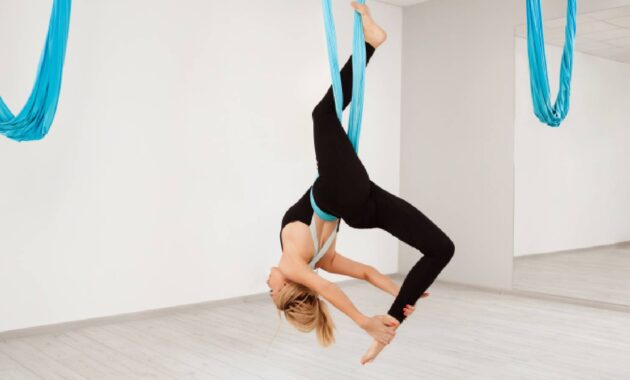Nothing compares to the feeling of indulging in a form of yoga that defies gravity! Aerial yoga not only looks interesting, and beautiful, but also comes with a host of health benefits, including healthy blood circulation, digestion and spine health. However, if you are all set to ditch your usual yoga routine or exercise regimen for aerial yoga, it is important to understand how to go about doing this complex form or exercise, its health benefits and why traditional yoga might still be a good option!
What is aerial yoga?
Aerial yoga, also known as anti-gravity yoga, requires you to be suspended in mid-air. Health Shots got in touch with holistic health and lifestyle coach Aarti Babhoota, Certified Trained Teacher in advanced Classical Hatha Yoga, to understand all about aerial yoga. “Aerial yoga is a requires the use of hammocks, ropes, yoga swings, and various props,” she says.

What are the benefits of aerial yoga?
There are many research-backed benefits of aerial yoga that would want to make you love this exercise form. Here are some of them
1. Adds flexibility to the body
According to a study published in Journal of Functional Morphology and Kinesiology, aerial yoga is great to build higher levels of flexibility, and also aids cardiorespiratory fitness and strength.
2. Great for cognitive function and attention span
Not only does aerial yoga help the body physically, but it helps improving cognitive function, thanks to the movement it entails. A study published in Frontiers in Human Neuroscience says that practicing choreographed movement helps strengthen attention span and memory as well.
3. Helps with weight loss
Well, here is our favourite benefit of aerial yoga! A study performed by the American Council on Exercise states that in a 50-minute session, you can burn 320 calories. It also helps in body fat percentage.

4. Helps the heart
Aerial yoga is also great for cardiovascular health. It helps with blood pressure as well as reduces risk of a heart attack, indicate studies.
5. Improves mental health
Aerial yoga keeps you happy, quite literally. A study published in Research in Dance Education, points out that aerial yoga is great for keeping depression at bay. It also helps in reducing stress levels.
5 tips to remember before starting aerial yoga
Aerial yoga requires a good and reliable set-up, and one also needs to prepare oneself to hang from the sky, quite literally we might add!
1. Training is integral
Individuals should be fully trained and have a thorough understanding of the practice. “The body needs to be prepared for the specific movements involved in aerial yoga,” says Babhoota.
2. Use correct props and a safe place to practice
It is essential to use the correct props and practice in a suitable space, preferably a certified aerial yoga studio. “Choosing the right studio is crucial for safety, and individuals should verify the instructor’s accreditation, checking their certifications and credentials,” explains Babhoota
3. Get the right clothes
It is very important to be dressed appropriately while practicing aerial yoga. Activewear, which covers your body entirely, is the best option for this kind of exercise. The ropes can cause friction against your skin, and activewear will provide protection against that.
4. Prepare yourself
Many people who do aerial yoga report feeling motion sickness initially. Your body needs to get comfortable with the movement and, hence, make sure to go slow, and follow the pace your body is comfortable with.
5. Inform your trainer about health conditions
Since it is a form of rigorous exercise, it is imperative that your trainer knows if you have any underlying health conditions. There are other forms of yoga that you can practice if you are pregnant.
Please note: Women who are pregnant or people with certain special health conditions must refer to their healthcare provider before trying this form of yoga.
What is the difference between traditional yoga and aerial yoga?
A one-or-the-other approach might not work! Both traditional yoga and aerial yoga come with its host of advantages. While aerial yoga might be more fun to follow, this does not mean that traditional yoga can be replaced by aerial yoga. “Contrasting aerial yoga with traditional yoga highlights a crucial distinction. Traditional yoga places emphasis on the harmonious coordination of body, breath, and mind, extending beyond mere physical advantages,” says Babhoota.
Also read: Bollywood actor Rakul Preet Singh loves aerial yoga! Here’s why
Also, aerial yoga might come with a certain concerns as well. “Yogic philosophy requires counterposes to restore balance. It remains uncertain if aerial yoga adequately incorporates these counterposes, given its emphasis on suspension in the air,” explains Babhoota.
Can you do aerial yoga at home?
To do aerial yoga at home, you should be willing to make a sturdy and safe set up. Ropes need to be installed in the same way that you would install a hammock, against strong beams or metal frames. “If you have just started learning aerial yoga at a studio, attempting aerial yoga at home can be highly risky. Aerial yoga involves stunts and poses that necessitate a well-equipped space and setup,” explains Babhoota.
Besides set up, you need to make sure you are fully trained before attempting this form of yoga alone. “It is crucial to ensure the right space, setup, and guidance when practicing aerial yoga, emphasising the importance of being fully trained before undertaking such practices independently,” she says.
Whatever you may choose, ensure that you support it with a healthy and balanced diet, as well as consistency and discipline.
#Aerial #Yoga #Benefits #home
